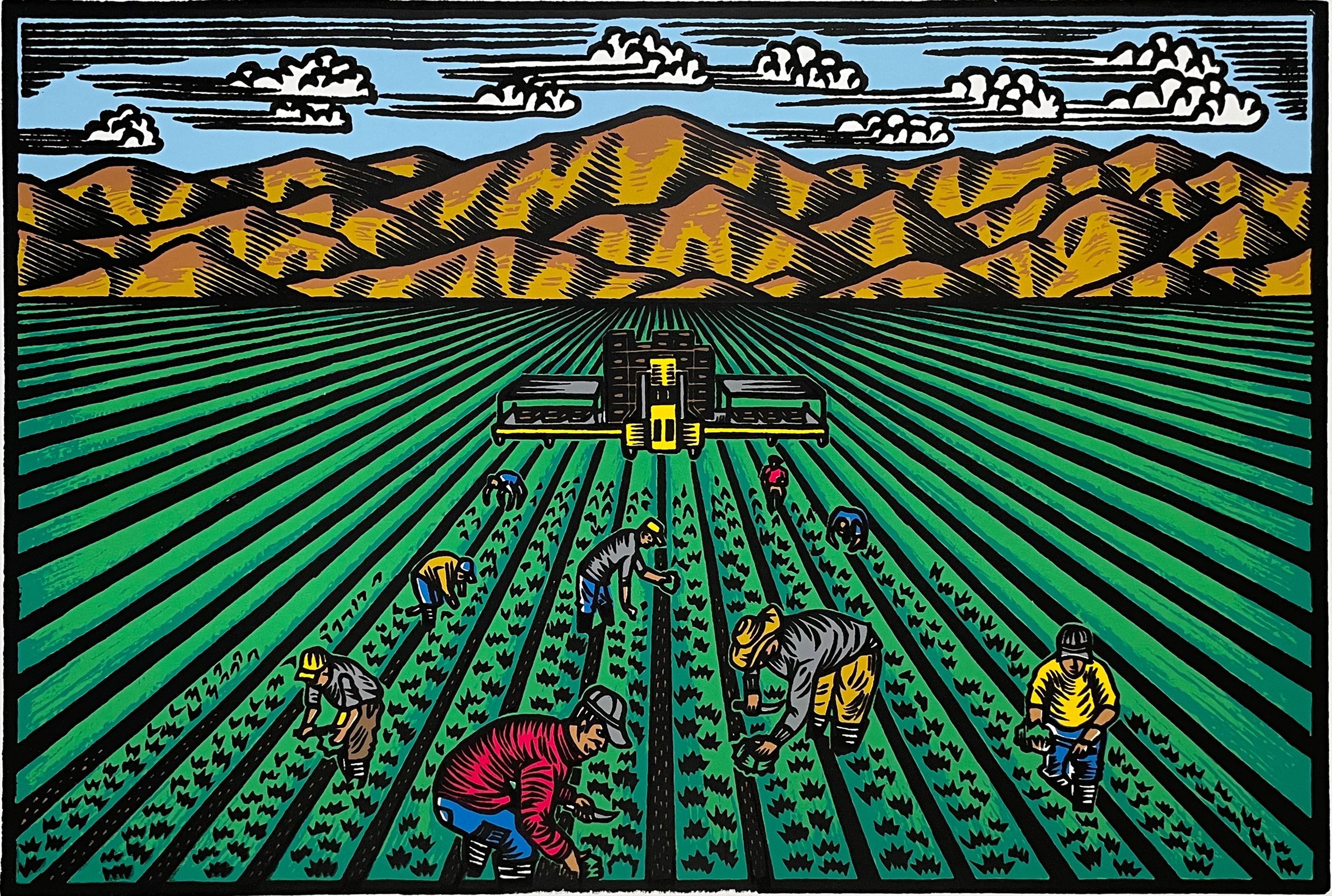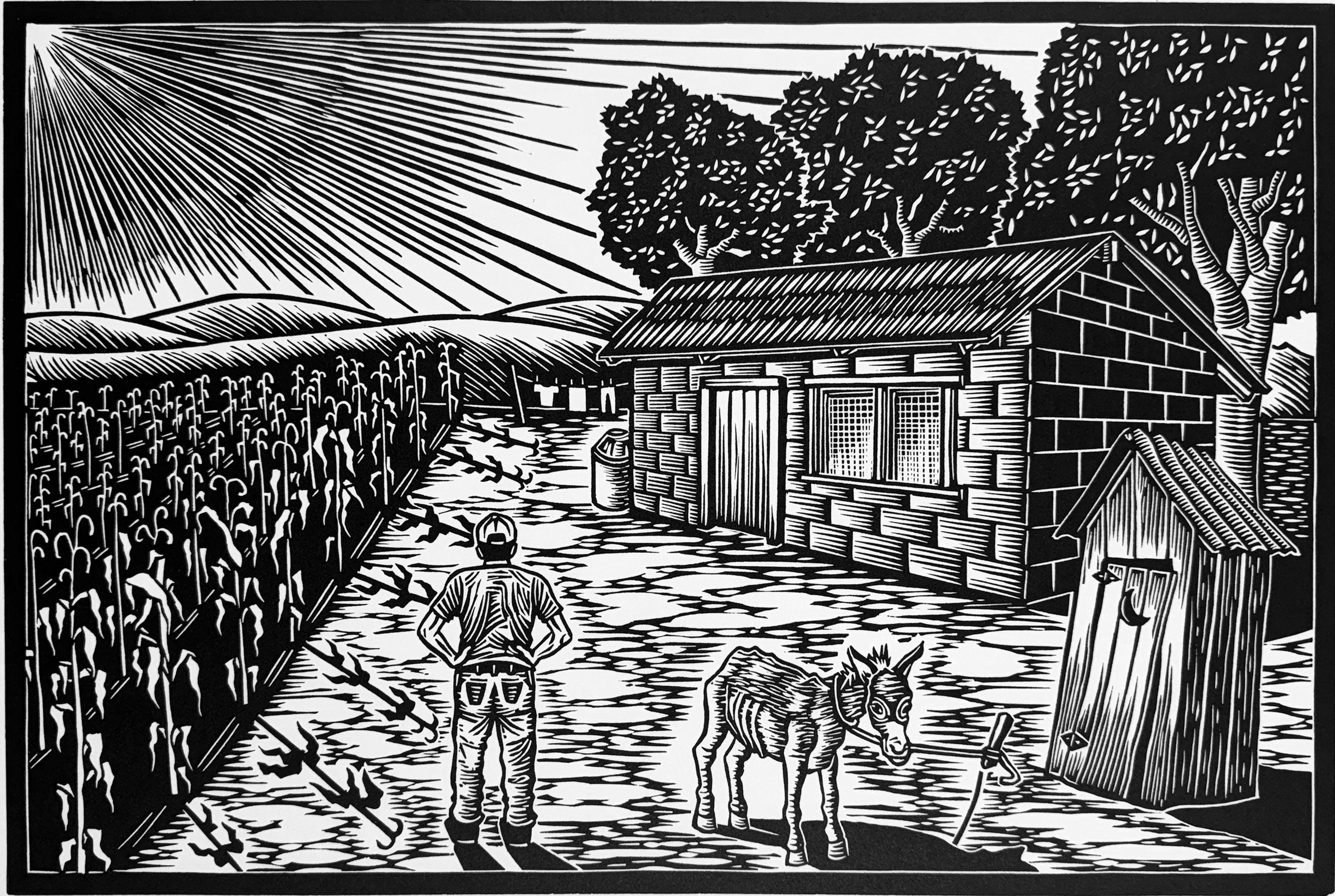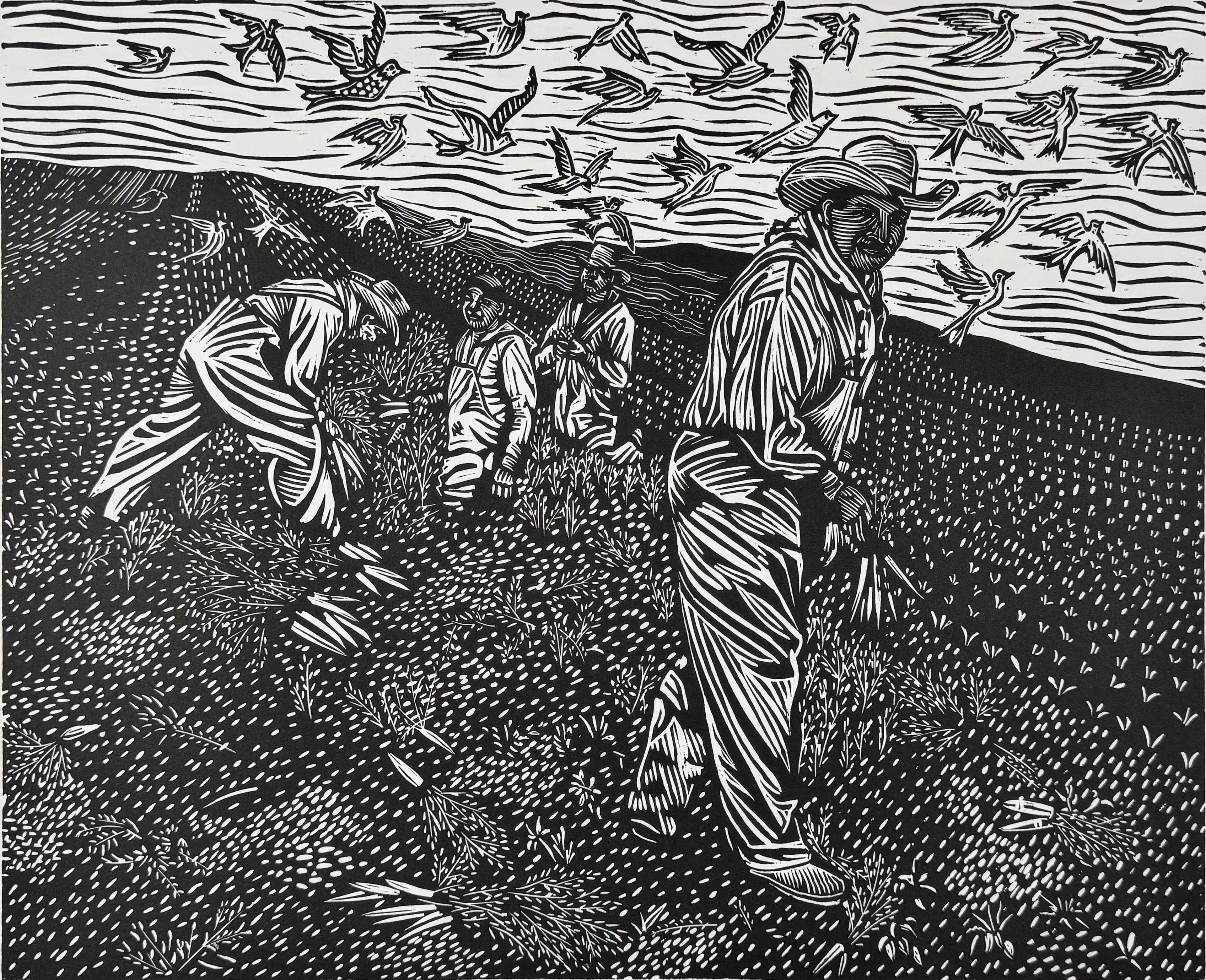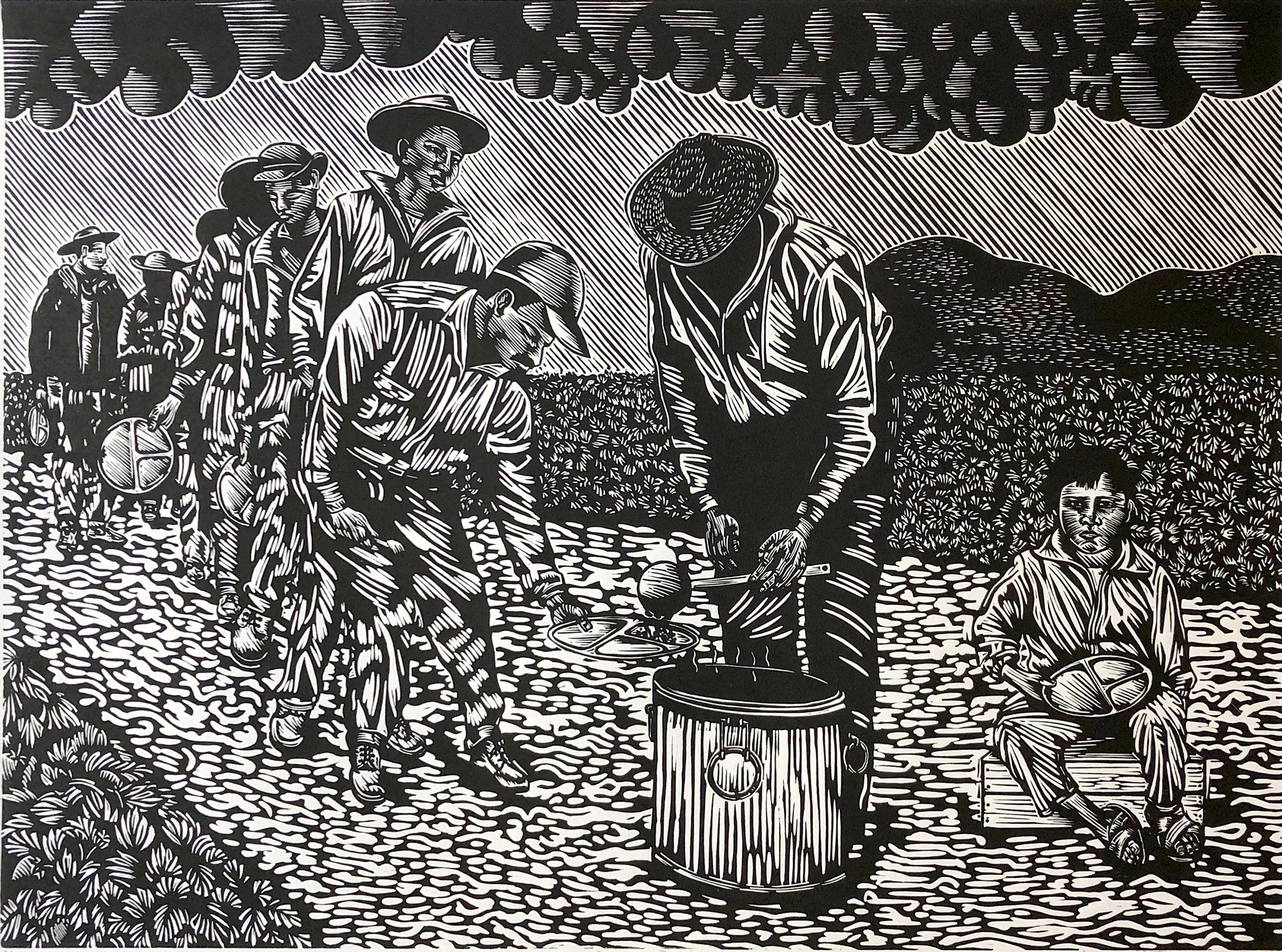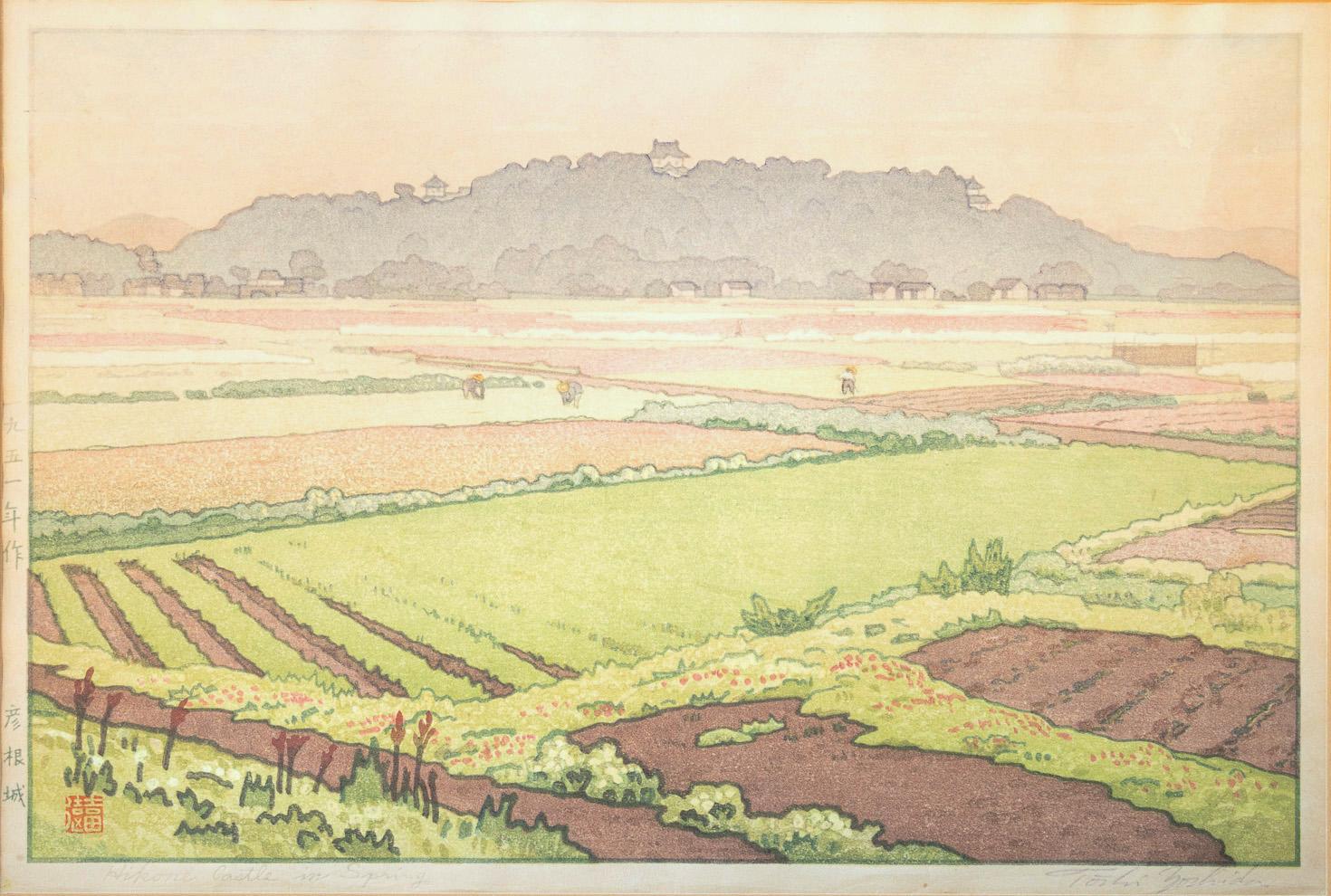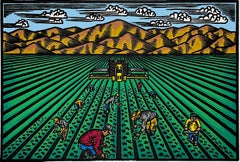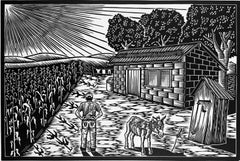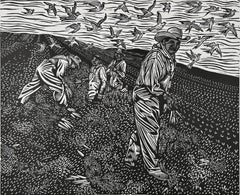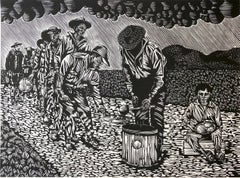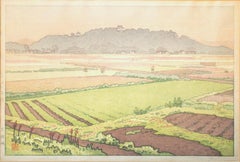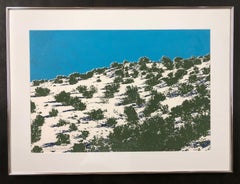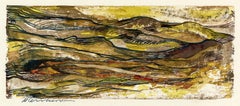Items Similar to Salinas Valley V.2 (letterpress editon)
Want more images or videos?
Request additional images or videos from the seller
1 of 9
Alvaro MarquezSalinas Valley V.2 (letterpress editon)2020
2020
$250
£189.21
€217.25
CA$356.15
A$386.25
CHF 202.87
MX$4,691.67
NOK 2,538.63
SEK 2,390.26
DKK 1,621.94
About the Item
Image size: 18 x 12 inches
Sheet size: 15x22 inches
Edition size: 140
Depicts farm workers harvesting lettuce in the artist's hometown of Salinas, CA. Printed at the historic Aardvark Letterpress in MacArthur Park, Los Angeles. Comes with the official studio “chop” along side that of Aardvark chopmark.
Dark brown ink on cream-colored 100% archival cotton-rag paper. Letterpress variation print of a linocut from the “Al Norte y P’atras/North and Back” series.
Álvaro D. Márquez is a visual artist and part-time professor of Chicana/o and Latina/o Studies at Cal State LA. Much of Marquez's work explores art as social inquiry, looking at the history of displacement in the Americas, starting with Indigenous dispossession after European conquest, following through to current issues around gentrification and homelessness.
Marquez was born into the working-class migrant community of East Salinas, in California’s Central Coast. Coming from three generations of migrant farm workers, his upbringing in this community informs his work as an artist, researcher, and advocate.
- Creator:Alvaro Marquez (American)
- Creation Year:2020
- Dimensions:Height: 15 in (38.1 cm)Width: 22 in (55.88 cm)
- Medium:
- Movement & Style:
- Period:
- Condition:
- Gallery Location:Palm Springs, CA
- Reference Number:1stDibs: LU308214481712
About the Seller
5.0
Recognized Seller
These prestigious sellers are industry leaders and represent the highest echelon for item quality and design.
Platinum Seller
Premium sellers with a 4.7+ rating and 24-hour response times
Established in 1998
1stDibs seller since 2015
538 sales on 1stDibs
Typical response time: <1 hour
- ShippingRetrieving quote...Shipping from: Palm Springs, CA
- Return Policy
Authenticity Guarantee
In the unlikely event there’s an issue with an item’s authenticity, contact us within 1 year for a full refund. DetailsMoney-Back Guarantee
If your item is not as described, is damaged in transit, or does not arrive, contact us within 7 days for a full refund. Details24-Hour Cancellation
You have a 24-hour grace period in which to reconsider your purchase, with no questions asked.Vetted Professional Sellers
Our world-class sellers must adhere to strict standards for service and quality, maintaining the integrity of our listings.Price-Match Guarantee
If you find that a seller listed the same item for a lower price elsewhere, we’ll match it.Trusted Global Delivery
Our best-in-class carrier network provides specialized shipping options worldwide, including custom delivery.More From This Seller
View AllSalinas Valley V.2
Located in Palm Springs, CA
11 layer-screen print on archival 100% cotton rag paper.
Measures 15x22 inches.
Based on original linocut from the Al Norte y P’atras/North and Back series. Depicts farm workers in my hometown of Salinas, California.
Álvaro D. Márquez is a visual artist and part-time professor of Chicana/o and Latina/o Studies at Cal State LA. Much of Marquez's work explores art as social inquiry, looking at the history of displacement in the Americas, starting with Indigenous dispossession after European conquest, following through to current issues around gentrification and homelessness.
Marquez was born into the working-class migrant community of East Salinas, in California’s Central...
Category
2010s Contemporary Landscape Prints
Materials
Screen
$275 Sale Price
21% Off
La Cosecha (The Harvest)
Located in Palm Springs, CA
Image size: 18 x 12 inches
Sheet size: 15x22 inches
Edition size: 21
Depicts farm worker contemplating his fields in Mexico.
Dark brown ink on cream-colored 100% archival cotton-r...
Category
2010s Contemporary Landscape Prints
Materials
Screen
$420 Sale Price
20% Off
En el Campo
By Juan Fuentes
Located in Palm Springs, CA
Signed and titled in pencil, edition of 12. Immigrant workers in the fields during harvest.
Juan R. Fuentes's print, "Bracero Brothers," reflects the Chicano Art Movement of the 1...
Category
2010s Contemporary Figurative Prints
Materials
Linocut
Bracero Brothers
By Juan Fuentes
Located in Palm Springs, CA
Signed and titled in pencil, edition of 20. Last print in the edition.
Juan R. Fuentes's print, "Bracero Brothers," reflects the Chicano Art Movement of the 1970s that he helped t...
Category
2010s Contemporary Figurative Prints
Materials
Linocut
Cosechando Alcachofas (harvesting artichokes), by Juan Fuentes
By Juan Fuentes
Located in Palm Springs, CA
Medium: linocut
Year: 2021
Image Size: 13 x 18 inches
Edition size: 10
Young migrant worker harvesting artichokes.
As a cultural activist/artist/printmaker, Juan Fuentes has dedicated his career to being part of a global movement for social change. His works address issues relating to local communities of color, social justice, and international struggles for liberation.
Fuentes' relief printing process follows closely the social realist tradition of Latin American artists such as Jose Guadalupe...
Category
2010s Contemporary Portrait Prints
Materials
Linocut
Fence Lines, by Stephen McMillan
By Stephen McMillan
Located in Palm Springs, CA
Hillside landscape with fence and wildflowers. A scene from the hills west of San Joaquin Valley, California.. Signed, titled and numbered from the edition of 120..
Born in Berkeley...
Category
Early 2000s Contemporary Landscape Prints
Materials
Etching, Aquatint
You May Also Like
Original Woodcut - Sheep Ranch
By Ina Annette
Located in Phoenix, AZ
Excellent Woodcut print by Oklahoma/New Mexico artist Ina Annette (1901-1990).
The image measures 10 ½ x 13 ½ inches. The work rests in a 17 1/4 x 20 1/4 inch museum mat.
The print i...
Category
Mid-20th Century Landscape Prints
Materials
Paper, Woodcut
"Green Farming" Japanese Landscape Woodblock Print
By Toshi Yoshida 1
Located in Austin, TX
Japanese woodblock print (etching) of a landscape by Toshi Yoshida
11" x 15" - Page Size
17 x 21.25 - Frame Size
Category
20th Century Landscape Prints
Materials
Etching
New Mexico Landscape by John Hogan, serigraph screen print limited edition
By John Hogan (American)
Located in Santa Fe, NM
New Mexico Landscape by John Hogan, serigraph screen print limited edition
#6/20 limited edition hand pulled screen print/serigraph
© 1977
John Hogan A graduate of Northeast Louisia...
Category
1970s Contemporary Landscape Prints
Materials
Screen
Mountainous Landscape, Mexico
Located in Fairlawn, OH
Mountainous Landscape, Mexico
Monotype in colors on heavy paper, c. 1960's
Signed in ink lower left "G Ceniceros"
Condition: Excellent
Image size: 6 x 14 1/2" (15.24 x 36.83cm)
Sheet size: 12 7/8 x 19 11/16 inches
Guillermo Ceniceros (born May 7, 1939) is a Mexican painter and muralist, best known for his mural work in Mexico City, as well as his figurative easel work. He began his mural painting career as an assistant to mural painters such as Federico Cantú, Luis Covarrubias and then David Alfaro Siqueiros who was a mentor and a key influence. Ceniceros is the most notable of Siqueiros' assistants. While he has experimented with abstract expression, his easel work mostly classifies as figurativism and is influenced by the geometrical construct of Mexican muralism. He has had over 300 individual and collective exhibitions in Mexico and the International stage. His work has been recognized by the Mexican Ministry of Culture and several of its institutions. He has painted over 20 large scale Mural Paintings with some of the most notable being the large scale work for the Legislative Palace of San Lazaro (Mexico's Legislative Building) as well as his murals in the Metro Subway System. He is a member of the Salón de la Plástica Mexicana. In 1995, the State of Durango, Ceniceros' native state, opened to the public the Guillermo Ceniceros Art Museum within the oversight of the Ministry of Culture. Ceniceros has been reviewed by notable critics such as Berta Taracena, Raquel Tibol, Alaide Foppa, Graciela Kartofel, José Angel Leyva and Eduardo Blackaller among others. There are several publications about his work including a vast review of his art life endeavors developed by the Ministries of Culture of Durango and Nuevo León. He is married to the artist Esther González and lives in his studio house in the Colonia Roma of Mexico City.
Life
Interview with the subject Ceniceros and Siqueiros
Ceniceros was born in a small village called El Salto, located in the municipality of Pueblo Nuevo in the Mexican state of Durango. His father was a woodworker who made toys and furniture in his workshop. His father's shop would become an influence in Ceniceros' life long interest in developing his own innovative working tools. When he was twelve the family moved to Monterrey to seek better economic opportunities. There he attended school and when he was fourteen he entered the Fabricación de Máquinas, S.A. (FAMA), a school/business, where he studied industrial drawing. He considers this early training important as it taught him the importance of geometry, use of space and materials. While at FAMA he met painters Gerardo Cantú and Ignacio Ortiz, and collaborated with them on sketches for publications of Alfonso Reyes, Pedro Garfias and other notable writers.
In 1955, he enrolled in the Taller de Artes Plásticas at the Universidad Autónoma de Nuevo León, graduating in 1958. At the Taller he met fellow Mexican artist Esther González, whom he married and with whom he has two children.
In 1962 he moved to Mexico City with the goal of working in the Taller of the Maestro David Alfaro Siqueiros. He became Siqueiros' first assistant working on his last murals while at the same time working at night on his easel painting work. Siqueiros supported Ceniceros decision to leave his Taller and supported him in his career until his death in 1974. By then Ceniceros was already a break thru artist having had several individual exhibitions including the prestigious Palacio De Bellas Artes as well as other recognitions. Thru the 70's and 80s Ceniceros continued his work with an emphasis on exhibits and exchanges abroad and traveling to Eastern Europe, Cuba, China, Chile, Ecuador, Italy and the United States. His Mexico City contemporaries and circle would include names that today have become reference such as Sebastian, José Luis Cuevas, Gilberto Aceves Navarro, Benjamin Dominguez, Gustavo Arias Murueta, Byron Galvez, Leonel Maciel among others. In the 70's his Row-House neighbors in the colonia Roma were Francisco Toledo and Alejandro Jodorowski.
His focus on mural painting is renewed in the mid 80's thru his large scale work in the Metro Subway System with him working on major commissions consistently and into the new century. While the Mexican school of Muralism had been challenged by the Ruptura members, the interest in Mural painting as a unique national form of expression continues.
He lives in Mexico City at a studio/home in the Colonia Roma. His home is a frequent gathering place for writers, poets, painters, singers, actors and journalists. He has a strong interest in Spanish language literature. Juan Rulfo...
Category
1960s Modern Landscape Drawings and Watercolors
Materials
Monotype
Landscape - Etching by Armando De Stefano - Late 20th century
By Armando De Stefano
Located in Roma, IT
Landscape is an original etching on paper realized by Armando De Stefano in the late 1970s.
Very Good conditions.
Hand-signed.
Numbered, Edition ...
Category
Late 20th Century Contemporary Landscape Prints
Materials
Etching
Countryside - Lithograph by Lucio Rofrano - 1990s
Located in Roma, IT
Lithograph realized by Lucio Rofrano in 1990s.
Edition of 150, numbered and hand signed.
Excellent condition.
Category
1990s Contemporary Figurative Prints
Materials
Lithograph
More Ways To Browse
Peter Max Two Hearts
Pierre Doutreleau
Raoul Dufy Paddock
Roy Lichtenstein Red Barn
Simon Pearce
Thomas Moran Lithograph
Venice Moretti
W Barker
Warhol Cathedral
Whistler Limehouse
1910 Etching Nyc
1919 Thomas Moran 1919
Altman Benches
Andy Warhol Brooklyn Bridge
Ann Reeves
Antony Gormley Horizon Field
Arthur John Strutt
Bill Ogden
